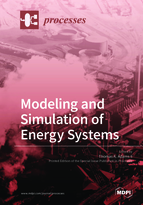Modeling and Simulation of Energy Systems
A special issue of Processes (ISSN 2227-9717). This special issue belongs to the section "Energy Systems".
Deadline for manuscript submissions: closed (31 October 2018) | Viewed by 138440
Special Issue Editor
Interests: sustainable energy conversion processes; modelling and simulation; new technologies for sustainable liquid fuel production; semi-continuous chemical separation processes
Special Issues, Collections and Topics in MDPI journals
Special Issue Information
Dear Colleagues,
One of the most important drivers of our economy is the production, management, conversion, and consumption of energy and energy products. It is fundamentally linked to many other important aspects of society, such as food production, water consumption, manufacturing, resource management, security, and the environment. Now more than ever, process systems engineers are in a position to address some of the most critical issues relating to energy systems and their impacts on the rest of the world. Advances in energy systems are being made at scales ranging from the international movement and trade of energy; industrial-scale refineries, biorefineries, and chemical plants; integrated energy systems for communities, districts, and neighbourhoods; and individual homes and buildings. The technologies involved can vary widely, such as traditional systems involving natural gas, petroleum, and transportation fuels, biofuels and bioproducts, synthetic and alternative fuels such as alcohols and ethers, nuclear energy, fuel cells, renewables such as wind and solar, and energy storage technologies of many varieties. All of these will be an important component of future of energy systems. Modeling and simulation plays a particularly important role in the development of these systems, since it is one of the most cost effective tools available for their design and analysis. In many cases, the use of models or simulations is the only way to make sound engineering judgements about new process concepts due to the massive scales involved.
This Special Issue on “Modeling and Simulation of Energy Systems” will curate novel advances in research which either use modeling and simulation as an important component of the analysis of energy systems, or, present the development of new and better models of energy systems or energy system components. In order to maximize impact, authors contributing to this Special Issue will be invited to deposit their process models in the open access repository for the process systems engineering community at PSEcommunity.org and/or provide as supplementary material. These may include contributions such as process simulation files, computer code, spreadsheets, model files, optimization codes, or other relevant digital objects used for modelling and simulation purposes with either commercial or open source software.
Topics include, but are not limited to:
- The development of models or simulations of individual process units contained within energy systems
- The development of models or simulations of energy process systems
- Simulation techniques, software, algorithms, or other tools for modeling and simulation
- Design, analysis, control, optimization, operation, planning, or scheduling of an energy system that employs models or simulations, such as techno-economic analyses, energy/exergy analyses, environmental or life cycle analyses, value and supply chains analysis, or other
Thanks and I hope you consider participating in this Special Issue.
Sincerely,
Prof. Dr. Thomas A. Adams II
Guest Editor
Manuscript Submission Information
Manuscripts should be submitted online at www.mdpi.com by registering and logging in to this website. Once you are registered, click here to go to the submission form. Manuscripts can be submitted until the deadline. All submissions that pass pre-check are peer-reviewed. Accepted papers will be published continuously in the journal (as soon as accepted) and will be listed together on the special issue website. Research articles, review articles as well as short communications are invited. For planned papers, a title and short abstract (about 100 words) can be sent to the Editorial Office for announcement on this website.
Submitted manuscripts should not have been published previously, nor be under consideration for publication elsewhere (except conference proceedings papers). All manuscripts are thoroughly refereed through a single-blind peer-review process. A guide for authors and other relevant information for submission of manuscripts is available on the Instructions for Authors page. Processes is an international peer-reviewed open access monthly journal published by MDPI.
Please visit the Instructions for Authors page before submitting a manuscript. The Article Processing Charge (APC) for publication in this open access journal is 2400 CHF (Swiss Francs). Submitted papers should be well formatted and use good English. Authors may use MDPI's English editing service prior to publication or during author revisions.
Keywords
- Modeling
- Simulation
- Energy Systems
- Systems Analysis
- Tools
- Algorithms
- Software
- Design
- Process Systems Engineering






